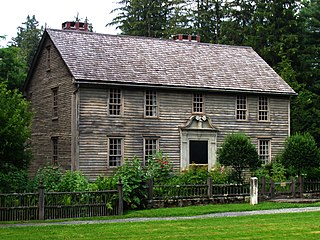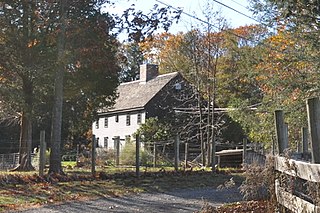
The Mission House is an historic house located at 19 Main Street, Stockbridge, Massachusetts. It was built between 1739 and 1742 by a Christian missionary to the local Mahicans. It is a National Historic Landmark, designated in 1968 as a rare surviving example of a colonial mission house. It is now owned and operated as a nonprofit museum by the Trustees of Reservations.

The Merrell Tavern, known more recently as the Merrell Inn, is a historic tavern at 1565 Pleasant Street in South Lee, Massachusetts. Built in 1794 as a residence, it has served for most of two centuries as a local traveler's accommodation, and retains fine Federal period architectural details. > It was added to the National Register of Historic Places in 1972. It continues to serve its historic function, and is now operated as a bed and breakfast inn.

The John Boardman House is a historic First Period house in Boxford, Massachusetts. Its oldest portion dates to about 1740, but has stylistically older elements. It was moved to its current location from Saugus in 1956, before which it had undergone restoration. It was listed on the National Register of Historic Places in 1990.

The Dr. John Calef House is a historic house at 7 Poplar Street in Ipswich, Massachusetts. It is a well-preserved example of a First Period house with high-quality Georgian modifications. The core of the house was built c. 1671 by Deacon Thomas Knowlton, who purchased the land on which it originally stood on South Main Street in that year. It was subsequently altered in the middle of the 18th century, acquiring its present Georgian styling. In the 1770s the house was owned by noted Loyalist John Calef. It was acquired in 1777 by John Heard, who moved the house to its present location in order to build a more elaborate Federalist house on the site.

Choate Bridge (1764) is a historic stone arch bridge carrying Route 1A/Route 133 over the Ipswich River in Ipswich, Massachusetts. It is one of the oldest surviving bridges in North America, and is probably the oldest in Massachusetts. It was listed on the National Register of Historic Places in 1972 and also has been designated as a National Historic Civil Engineering Landmark.

The Isaac Goodale House is a historic house in Ipswich, Massachusetts. Built about 1700, the house has many original First Period elements, despite its relocation to its present location in 1928. The house was listed on the National Register of Historic Places in 1990, and is the subject of a preservation easement held by the Ipswich Historic Commission.

Meetinghouse Green Historic District encompasses the historic 17th century heart of Ipswich, Massachusetts. The district runs along North Main Street, south from its junction with High Street to the southern end of the Meetinghouse Green. It was listed on the National Register of Historic Places in 1980.

The Ipswich Mills Historic District encompasses a major textile mill complex and associated worker housing along the Ipswich River near the center of Ipswich, Massachusetts. The district includes the factories of the Ipswich Mill Company, and several blocks of modest worker cottages mostly on side streets off Estes and Kimball Streets. The site had been used as for mills since the 17th century, and was purchased by the Ipswich Mill Company in 1868. Mill worker housing was built surrounding the complex through the early 20th century, when River Court, Peatfield Street, and 1st through 6th Streets were laid out. The district was listed on the National Register of Historic Places in 1996.

The Howe Village Historic District is a historic district in Boxford, Massachusetts. It encompasses an area in and around Massachusetts Route 97, just east of Interstate 95 and south of the junction of those two roads, and includes most of the properties on Ipswich Road and a few on adjacent roads. This area was among the first to be settled in what is now Boxford, and consists of a rural cluster of houses built between about 1750 and 1850. The district was listed on the National Register of Historic Places in 1973.

The Howe Barn is a historic barn, that has been converted into a house, in Ipswich, Massachusetts, United States. It is important as one of a small number of surviving First Period barn frames in Essex County. Family tradition places the construction of the barn to c. 1711 by Abraham Howe, an early settler of the Linebrook Road area. Elements of the frame, which are still visible in the attic and some areas left exposed during the 1948 conversion to a house, bear some resemblance to a similar period barn at the Stanley Lake House in nearby Topsfield.

The White–Ellery House is a historic house located at 247 Washington Street in Gloucester, Massachusetts. It is on the National Register of Historic Places. It is owned and operated by the Cape Ann Museum, whose headquarters is located at 27 Pleasant Street in Gloucester.

The Nathaniel Rust Mansion is a historic house at 83 County Street in Ipswich, Massachusetts. It is a 2+1⁄2-story colonial style house with First Period origins, indicated in part by its asymmetrical front facade. The date of its construction is uncertain; the first record of the house is its sale by Deacon William Goodhue to Nathaniel Rust, a tanner, in 1665. It was for many years located on the South Green, but was moved to its present location on County Street in 1837 by Asa Brown. Brown at the same time made modifications to the house, giving it its Federalist character. The house is one of the oldest houses in Ipswich that is situated outside one of its central historic districts.

The Hopestill Bent Tavern is a historic First Period tavern in Wayland, Massachusetts, United States. The oldest portion of this 2+1⁄2-story building was built on this site c. 1710, and consisted of two rooms with a central chimney. Around 1800 a second First Period structure was moved to the site and attached to the first, giving the building most of its present form. The building is also unusual for the period in that some of its rooms have no fireplace, and that the upstairs exhibits evidence of significant reuse of older building materials, a practice that was generally restricted to the attic or basement. The building exhibits modest Federal styling, in keeping with the c. 1800 alterations. Its builder and first proprietor was Hopestill Bent (1672–1725).

The Cooper–Davenport Tavern Wing is a historic building in Somerville, Massachusetts. Built c. 1806 by John Davenport as a wing to a 1757 tavern built by Jonathan Cooper, this is one of the few Federal-period buildings to survive in the city. Moved to its present location in the 1880s, it now houses residences. The building was listed on the National Register of Historic Places in 1989.

The Jerry Nichols Tavern is an historic house in Reading, Massachusetts. It is a 2+1⁄2-storey wood-frame structure, five bays wide, with a side gable roof, central chimney, and clapboard siding. The main entrance is flanked by pilasters and topped by an entablature. The oldest portion of the house was built in 1785 by Jeremiah Nichols, a Revolutionary War veteran, farmer, and shoemaker. This property was where Reading's minute companies drilled prior to the American Revolutionary War, and where its powder magazine was kept. The building was expanded 1810–13, and had by 1830 been adapted as a tavern and stage coach stop. In 1824 it was bought by Rev. Peter Sanborn, in whose family it remained into the 1940s.

Stearns Tavern is a historic tavern in Worcester, Massachusetts. The building is one of the best extant examples of vernacular Federal style architecture in the city. Its construction is dated to c. 1812 based on 19th-century historical sources, and it was suggested that its frame may be even older, based on analysis conducted during a 1974 move of the building. The building is a two-story timber-frame house, with a two-story ell on the northeast. The front door is a distinctive six-panel door, flanked by sidelights and topped by a fanlight. Originally located at 1030 Main Street, it was moved in 1974 to 651 Park Avenue and converted for use as a bank. Restoration done at the time exposed Federal style details that had been covered over in the intervening years. It was located at 651 Park Avenue in Worcester, Massachusetts from 1974 to 2016.

This is a list of the National Register of Historic Places listings in Ipswich, Massachusetts.
The Riverside Village Historic District encompasses a village community near Massachusetts Route 2 in Gill, Massachusetts. The district was listed on the National Register of Historic Places in 1992.
This article attempts to list the oldest houses built in the Commonwealth of Massachusetts, United States from settlement to 1659. The first immigrant houses built in the Plymouth and Massachusetts Bay colony are known as first generation structures. These were built upon settlement (1620) until about 1660 “when the first immigrant generation of preponderantly younger settlers had come to full maturity". While dozens of existing homes are thought to have been built before 1660, proving their age scientifically is another matter. Just one example built during this time period known as the Fairbanks House has been proven through dendrochronology. The rest of the examples are approximate and based on architectural studies and historical records. Its estimated that only 5 houses in total have been documented enough to firmly establish they were built during this time period. Only First Period houses built prior to 1660 are suitable for inclusion on this list as construction methods changed circa 1660. All entries should include citation with reference to: 17th century architectural features; a report by an architectural historian; or dendrochronology whenever possible.




















